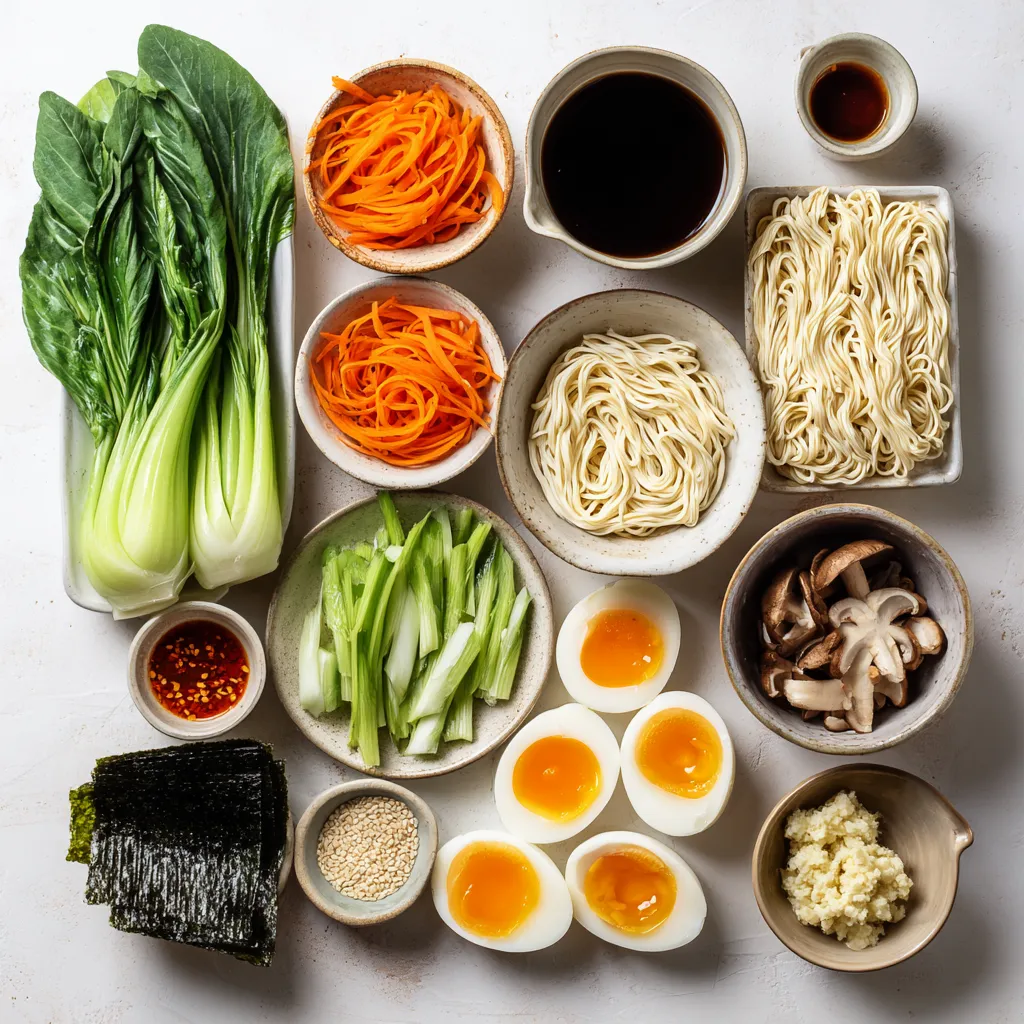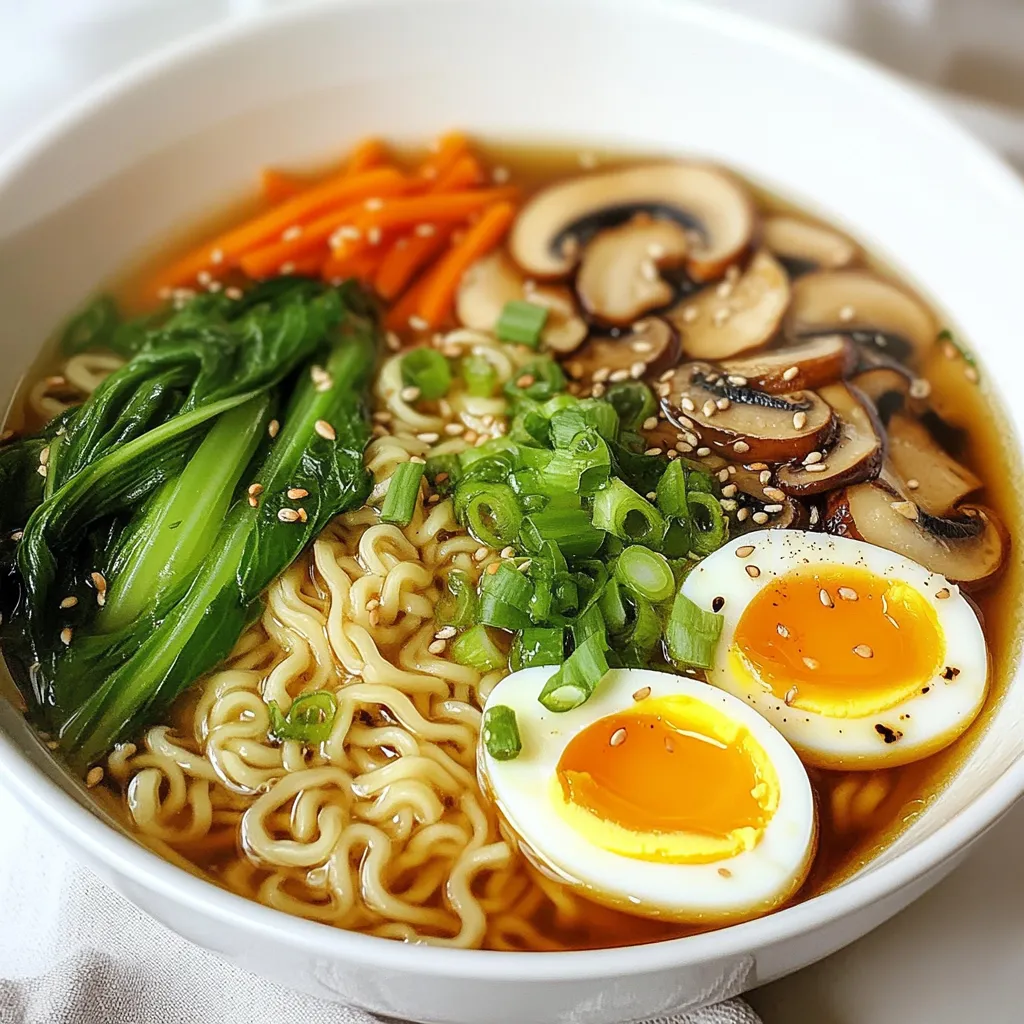Are you ready to make a delicious bowl of homemade ramen? This simple guide will take you through each step. I’ll share easy ingredients, cooking tips, and variations to suit your taste. Whether you crave classic soy sauce ramen or want to get creative with toppings, you’ll find it here. Let’s turn your kitchen into a ramen shop and impress your friends and family with flavorful homemade bowls!
Why I Love This Recipe
- Comforting Flavor: This ramen is a warm hug in a bowl, filled with rich umami flavors that satisfy the soul.
- Quick and Easy: With a total prep time of just 30 minutes, you can whip up this delicious meal even on a busy weeknight.
- Customizable: Feel free to add your favorite veggies or proteins, making it a versatile dish that suits everyone’s taste.
- Healthy Ingredients: This recipe is packed with fresh vegetables and rich in nutrients, ensuring a wholesome dining experience.
Ingredients
List of Main Ingredients
- 4 cups chicken or vegetable broth
- 2 servings of fresh ramen noodles
- 1 cup baby bok choy, halved
- 1 medium carrot, julienned
- 2 green onions, sliced
- 1 cup shiitake mushrooms, sliced
- 2 garlic cloves, minced
- 1 tablespoon ginger, minced
- 2 tablespoons soy sauce
- 1 tablespoon miso paste
- 2 teaspoons sesame oil
- 2 soft-boiled eggs (for topping)
- Nori sheets, cut into strips (for garnish)
- Sesame seeds (for garnish)
- Chili oil (optional, for serving)
The ingredients for homemade ramen are simple, yet they create a rich flavor. You need broth as the base. It can be chicken or vegetable broth. This choice affects the taste of the soup. Fresh ramen noodles are a must. They cook quickly and add texture to the dish.
Next, you’ll want to add some vegetables and toppings. Baby bok choy gives a nice crunch. Julienned carrots add color and sweetness. Sliced shiitake mushrooms bring an earthy taste. Green onions add a fresh kick on top.
For seasonings, garlic and ginger are essential. They add depth to your broth. Soy sauce and miso paste enhance umami flavors. Sesame oil gives a nutty aroma.
Finally, soft-boiled eggs make a creamy topping. Nori sheets and sesame seeds add visual appeal. If you like some heat, a drizzle of chili oil is a great option.
Gather all these ingredients, and you’re ready to make a delicious bowl of ramen.

Step-by-Step Instructions
Preparation
Sautéing garlic and ginger
Start by heating 2 teaspoons of sesame oil in a large pot over medium heat. Add 2 minced garlic cloves and 1 tablespoon of minced ginger. Sauté them for about 30 seconds. You want to smell that sweet aroma fill your kitchen. This step adds a deep flavor to the broth.
Cooking shiitake mushrooms
Next, add 1 cup of sliced shiitake mushrooms to the pot. Cook them for 4 to 5 minutes. Stir them often until they become tender. This step brings out their rich umami flavor, making the ramen even tastier.
Simmering the Broth
Adding broth and miso paste
Pour in 4 cups of chicken or vegetable broth. Bring it to a simmer. Then, stir in 2 tablespoons of soy sauce and 1 tablespoon of miso paste. Mix well until everything is combined. This creates a warm and savory base for your ramen.
Incorporating vegetables
Add 1 cup of halved baby bok choy and 1 medium julienned carrot to the pot. Let them cook for about 3 to 4 minutes. This step helps the vegetables stay crisp and colorful, adding both nutrition and beauty to your dish.
Noodle Cooking Technique
Cooking ramen noodles
In a separate pot, bring water to a boil. Add 2 servings of fresh ramen noodles and cook them according to the package instructions, usually about 3 to 4 minutes. Drain the noodles and set them aside. This step ensures that the noodles stay firm and do not get mushy.
Assembling the dish
To serve, divide the cooked noodles into two bowls. Ladle the hot broth with vegetables over the noodles. Halve 2 soft-boiled eggs and place one half on top of each bowl. Finally, garnish with sliced green onions, nori strips, and sesame seeds. If you like heat, drizzle some chili oil on top. Enjoy your homemade ramen!
Tips & Tricks
Achieving the Perfect Broth
To make a great broth, simmer it gently. This helps the flavors mix well. Start with good broth, either chicken or vegetable. Use fresh ingredients like garlic and ginger. They add depth and warmth. Stir in soy sauce and miso paste for a nice umami kick. Let it simmer for about 10-15 minutes. This gives the broth time to develop flavor.
To enhance the taste, try adding seaweed or dried mushrooms. They boost the umami flavor, making your broth richer. You can also add a splash of rice vinegar for brightness.
Noodle Cooking Best Practices
Cooking your noodles just right is key. Ramen noodles should be al dente, which means they should have a slight bite. Boil water in a separate pot before cooking your noodles. Follow the package instructions, usually 3-4 minutes. Stir them gently to avoid sticking.
When done, drain the noodles quickly. Rinse them under cold water to stop cooking. This keeps them from getting mushy. Timing is crucial, so keep an eye on the clock!
Presentation and Serving Suggestions
Garnishing makes your ramen look and taste better. Add sliced green onions and nori strips on top for color and crunch. A sprinkle of sesame seeds adds a nice touch too. Don’t forget the soft-boiled egg; it’s a tasty must-have.
Serve the ramen in deep bowls. This keeps the broth hot and makes it easy to eat. You can drizzle chili oil on top if you like spice. Enjoy the layers of flavor and texture you created!
Pro Tips
- Broth Boost: To enhance the umami flavor, consider adding a splash of fish sauce or a few dried shiitake mushrooms while simmering the broth.
- Perfect Noodles: Be mindful not to overcook the ramen noodles; they should remain slightly firm to the bite, as they will continue to cook when added to the hot broth.
- Vegetable Variations: Feel free to customize your ramen by adding other vegetables like broccoli, bell peppers, or spinach for more color and nutrients.
- Egg Excellence: For the best soft-boiled eggs, simmer them for exactly 6-7 minutes, then plunge them into ice water to stop the cooking process and make peeling easier.

Variations
Different Broth Types
You can change the flavor of your ramen by using different broth types.
- Shoyu (soy sauce) ramen: This broth uses soy sauce for a rich, savory taste. It’s a popular choice for many. The soy sauce adds umami and depth.
- Miso ramen: This broth is creamy and flavorful. Miso paste gives it a unique taste. It’s great for a hearty meal.
- Tonkotsu (pork bone) ramen: This broth is made from simmered pork bones. It has a rich, creamy texture. This option is perfect for meat lovers.
Noodle Alternatives
If you want some variety, try these noodle options.
- Gluten-free options: Rice noodles or other gluten-free noodles work well. They can fit into many diets.
- Udon and soba noodles: Udon is thick and chewy. Soba is thinner and made from buckwheat. Both add a new twist to your ramen.
Topping Adjustments
Toppings can make your ramen special. Here are some ideas.
- Additional protein options: You can add chicken, beef, or tofu for extra protein. Each adds its own flavor.
- Seasonal vegetables: Use fresh, seasonal veggies like spinach or corn. They add color and nutrition to your bowl.
Feel free to mix and match these options as you create your perfect bowl of homemade ramen!
Storage Information
Storing Leftover Broth
To keep your leftover broth fresh, follow these tips:
- Best practices for refrigeration: Store the broth in an airtight container. It can last for up to three days in the fridge. Let it cool first before sealing it. This helps prevent bacteria growth.
- Freezing techniques: For longer storage, freeze the broth. Use freezer-safe containers or bags. Broth can last up to three months in the freezer. Make sure to leave space in the container for expansion.
Keeping Noodles Fresh
Noodles need special care to stay fresh:
- Storage tips for uncooked noodles: Keep uncooked ramen noodles in a cool, dry place. A pantry or cupboard works best. Use them within a few months for best taste.
- Tips for reheating cooked noodles: To reheat cooked noodles, add a little water. Microwave them for one minute, stirring halfway. This keeps them from drying out and makes them soft again.
Vegetable and Topping Storage
Fresh ingredients need proper handling:
- Proper handling of fresh ingredients: Keep vegetables in the fridge. Use them within a week for best flavor. Wrap leafy greens in a damp paper towel to keep them crisp.
- Shelf life of toppings: Toppings like eggs and nori should be used within three days. Store eggs in the carton and nori in a cool, dry place. This keeps them fresh and tasty for your next ramen bowl!
FAQs
What is the best way to make homemade ramen broth?
To make great ramen broth, start with key ingredients. Use chicken or vegetable broth. Add soy sauce and miso paste for deep flavor. Garlic and ginger bring warmth and spice. Shiitake mushrooms add umami, while vegetables like bok choy and carrots give texture.
For cooking time, simmer the broth for about 20 minutes. This allows the flavors to meld well. The result is a rich, savory broth that enhances your ramen experience.
How can I make ramen noodles from scratch?
Making ramen noodles is fun and simple. You will need flour, water, and salt. Start with 2 cups of all-purpose flour. Mix in 1/2 cup of water and a pinch of salt. Knead the dough until smooth. Let it rest for 30 minutes.
For tools, you’ll need a rolling pin and a knife. Use the rolling pin to thinly roll out the dough. Cut it into thin strips for noodles. Fresh noodles cook quickly, usually in just 3-4 minutes.
Can I customize my ramen toppings?
Yes, you can! Popular toppings include soft-boiled eggs, sliced green onions, and nori strips. You can also add proteins like chicken, pork, or tofu. For veggies, consider corn, spinach, or bean sprouts.
Be mindful of allergies. If someone has a soy allergy, use gluten-free soy sauce or skip it. Always check ingredient labels to keep everyone safe while enjoying your ramen!
In this blog post, we explored how to make a delicious bowl of ramen. We discussed the main ingredients, step-by-step instructions, and tips for perfecting your broth and noodles. I shared variations and storage methods to help you customize and keep your ramen fresh. Ramen is not just a meal; it’s an experience. With practice, you can create a tasty dish that suits your tastes and impresses anyone who shares it with you. Enjoy making your ramen and happy cookin

Umami-Fusion Homemade Ramen
Ingredients
- 4 cups chicken or vegetable broth
- 2 servings fresh ramen noodles
- 1 cup baby bok choy, halved
- 1 medium carrot, julienned
- 2 pieces green onions, sliced
- 1 cup shiitake mushrooms, sliced
- 2 cloves garlic, minced
- 1 tablespoon ginger, minced
- 2 tablespoons soy sauce
- 1 tablespoon miso paste
- 2 teaspoons sesame oil
- 2 pieces soft-boiled eggs (for topping)
- 1 sheets nori, cut into strips (for garnish)
- to taste sesame seeds (for garnish)
- optional chili oil (for serving)
Instructions
- In a large pot, heat sesame oil over medium heat. Add minced garlic and ginger; sauté for about 30 seconds until fragrant.
- Add sliced shiitake mushrooms and cook for 4-5 minutes until tender.
- Pour in the chicken or vegetable broth and bring it to a simmer. Stir in the soy sauce and miso paste until well combined.
- Add bok choy and julienned carrots to the broth, allowing them to cook for about 3-4 minutes until tender.
- Meanwhile, in a separate pot, bring water to a boil and cook the ramen noodles according to package instructions, usually 3-4 minutes. Drain and set aside.
- To assemble, divide the cooked noodles into serving bowls. Ladle the hot broth with vegetables over the noodles.
- Halve the soft-boiled eggs, placing one half on top of each bowl.
- Garnish with sliced green onions, nori strips, and sesame seeds. Drizzle with chili oil if desired for extra spice.


